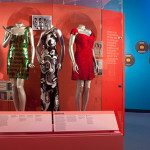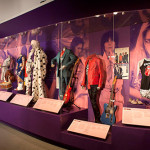An inside look at “Women Who Rock: Vision, Passion, Power” at the National Museum of Women in the Arts
After entering D.C.’s National Museum of Women in the Arts (NMWA) to view the “Women Who Rock: Vision, Passion, Power” exhibition, I encountered Lady Gaga’s childhood piano (1966)—the same piano that enabled her to rock and queer the minds of music lovers around the world. But she did not create this vision of change on her own. It was built by the foremothers of rock: Ma Rainey (1920s blues), Wanda Jackson (1950s rockabilly queen), The Supremes (1960s girl group), Tina Turner and Cher (’60s), Patti Smith (’70s), and Madonna (’80s), to name few. And, some of these trailblazers are still recording and touring today.
The display of the changing ways of female rock is massive, and NMWA organized the exhibition into eight eras: (1) Suffragettes to Juke-Joint Mamas: The Foremothers/Roots of Rock; (2) Get Outta That Kitchen, Rattle Those Pots and Pans: Rock and Roll Emerges; (3) Will You Love Me Tomorrow: The Early 1960s/Girl Groups; (4) Revolution, the Counterculture, and the Pill: The Late 1960s; (5) I Will Survive: The 1970s—Rockers to Disco Divas; (6) Dance This Mess Around: Punk and Post Punk; (7) Causing a Commotion: Madonna and the Pop Explosion; and (8) Ladies First: The ’90s and the New Millennium.
Each era highlights female rockers and features highly stimulating artifacts from the artists themselves, such as song lyrics, photos, and fashion items. Turning left from Lady Gaga’s piano, I saw Patti Smith’s worn-out punk-styled black boots. Next, I was immediately drawn to Cher’s famous “Costume of Half-Breed.” It then occurred to me that although these pioneers were changing the role and expectations of women through music, they were also doing so with the clothes and objects they chose to wear on their bodies. Thus, the power of rock and, ultimately, female empowerment is revealed not only in the music, but also in the performance and the materialization of it.
For each musical era in the exhibition, the sounds and visuals of the other eras blend into one another, underscoring the way in which music builds from previous historical contexts. For example, Loretta Lynn’s 1975 album Back to the Country features “The Pill,” a scandalous song about a rural woman asserting her reproductive rights. These lyrics recall the women’s cultural revolution of the late ’60s. And, Ma Rainey’s reference to homosexuality in her song “Prove It On Me Blues”— written, performed, and recorded in 1928—helped encourage women to come out of the closet. As Melissa Etheridge says, “Don’t let anyone tell you that you have to be a certain way. Be unique. Be what you feel.”
Change is rooted in the wise words and courageous deeds of the women who came before us. If you love women and history, and if you want to experience change or be a change-maker, then check out the “Women Who Rock” exhibition. It is open through January 6, 2013, at the National Museum of Women in the Arts, New York Avenue and 13th Street, NW, Washington, D.C.; 202-783-5000; nmwa.org.





